Explore Nyanga - Zimbabwe Travel, Africa
Nyanga, nestled in Zimbabwe's breathtaking Eastern Highlands, is a destination that promises awe-inspiring natural beauty and rich cultural experiences. Known for its stunning landscapes and serene environment, Nyanga offers a refreshing escape from the bustle of city life. Whether you're an avid nature lover, an adventure seeker, or someone eager to immerse yourself in local culture, Nyanga has something special for you. With its lush mountain ranges, vibrant local traditions, and diverse activities, this hidden gem is an ideal spot for your next travel adventure.
Population: Approximately 58,000 in 2011.
Economy: Nyanga’s economy thrives on agriculture, tourism, and small-scale trade. Farming, particularly of crops and livestock, alongside eco-tourism, supports local livelihoods and drives economic activity.
Landmarks: Famous for the Nyanga National Park, Mutarazi Falls, and the World’s View.
Zimbabwe
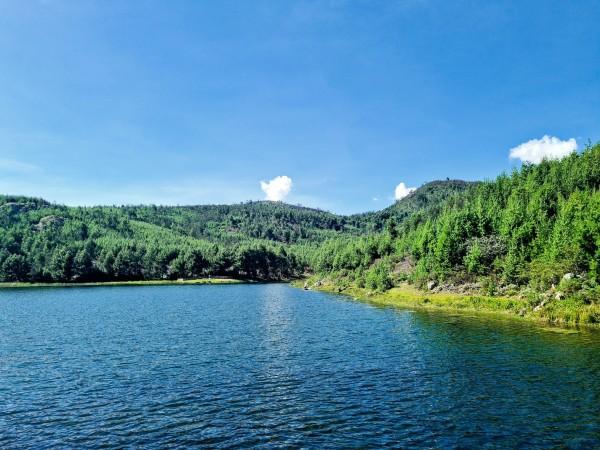
Overview of Nyanga
History & Culture Influence
Nyanga is a region steeped in history and culture. The area's history stretches back to the ancient Shona civilization, which left a lasting impact on the region's cultural landscape. The Shona people, known for their intricate stonework and vibrant traditions, have shaped Nyanga's cultural identity. During the colonial era, Nyanga became a significant site due to its strategic location and natural resources. This period introduced new influences while blending with the existing Shona traditions to create a unique cultural tapestry. Today, Nyanga’s history is reflected in its architecture, traditional ceremonies, and local art. Visitors can explore ancient ruins like the Great Zimbabwe Ruins and experience traditional music and dance that celebrate the region's heritage.
Interaction with the Locals
Nyanga, a picturesque town in Zimbabwe's Eastern Highlands, is home to a vibrant and diverse community. The town is predominantly inhabited by the Shona people, who are known for their rich cultural traditions and warm hospitality. The local community plays a crucial role in preserving Nyanga's heritage and welcoming visitors with genuine friendliness. This close-knit population contributes to the region's unique charm and cultural depth, making it an inviting destination for travelers.
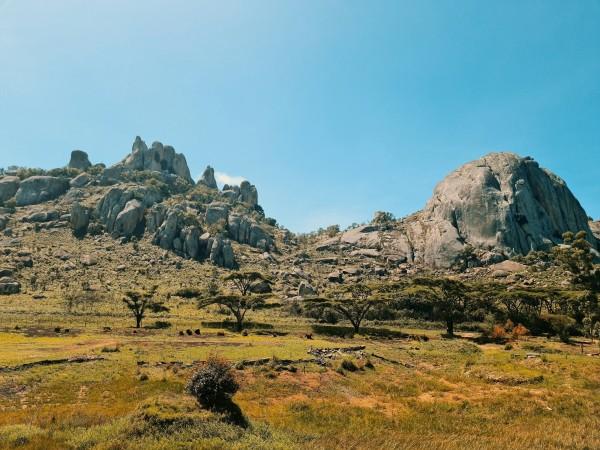
Nyanga National Park - © Rutendo Petros
Top Attractions in Nyanga
Nyanga’s top attractions offer an array of experiences that showcase the region’s natural beauty and unique charm. These attractions capture the essence of Nyanga’s natural splendor and offer a variety of ways to explore and appreciate the region’s unique environment.
Nyanga National Park
This expansive park is a paradise for nature lovers and outdoor enthusiasts. It has a varied ecology, ranging from lush woods to harsh peaks. The park is home to Mount Nyangani, Zimbabwe’s highest peak, which offers breathtaking panoramic views and challenging hiking trails. Visitors can also explore the park’s rich wildlife, including antelope and various bird species, while enjoying serene landscapes and refreshing mountain air.
Mutarazi Falls
Renowned for its impressive height and dramatic beauty, Mutarazi Falls is a must-see natural wonder. The falls cascade over rugged cliffs into a deep pool below, surrounded by lush vegetation. The region has breathtaking views and a tranquil atmosphere, ideal for a leisurely visit or a refreshing plunge in the cold waters.
World’s View
For those seeking breathtaking vistas, World’s View is the ideal destination. This scenic viewpoint provides expansive views of the Eastern Highlands, including rolling hills and verdant valleys. It’s an excellent spot for photography and enjoying the tranquil beauty of Nyanga’s landscape.
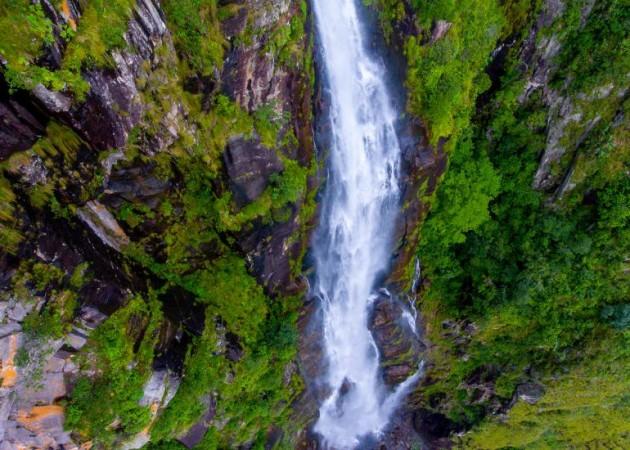
Mutarazi Falls - © Zimbabwe Tourism
Must-Try Dishes in Nyanga
Nyanga’s culinary tradition is a delightful reflection of Zimbabwean cuisine, offering a range of traditional dishes that are both flavorful and satisfying. Sampling these dishes provides a true taste of Nyanga’s culinary heritage, allowing visitors to experience the authentic flavors of Zimbabwean cuisine.
- Sadza: A staple in Zimbabwean cuisine, sadza is a thick maize porridge often served as the base for a variety of dishes. It pairs perfectly with meats, vegetables, and stews, making it a central part of any meal in Nyanga.
- Nyama: Nyama refers to meat, commonly beef, goat, or chicken, cooked with spices and herbs. It is often grilled or stewed, offering a rich and savory taste that complements the mild flavor of sadza.
- Kapenta: These small, dried fish are a popular delicacy in Nyanga. Kapenta is typically fried and served with vegetables or added to stews, providing a unique and savory flavor that enhances local dishes.
- Mopane Worms: These protein-rich insects are a traditional snack in Zimbabwe. Prepared by drying or frying, mopane worms are a crunchy and flavorful treat that reflects the region’s diverse culinary practices.
- Vegetable Stews: Nyanga’s vegetable stews are often made with locally grown produce like tomatoes, spinach, and onions. These stews are seasoned with traditional spices and served as a side dish or a main meal.

Kapenta - © Shumba Africa
Festivals & Local Celebrations
Nyanga’s vibrant festivals and local celebrations provide a deep dive into the cultural richness of Zimbabwe’s Eastern Highlands. Each of these festivals and celebrations offers a unique opportunity to engage with Nyanga’s local culture, making them a must-experience for anyone visiting the region.
Harvest Festivals
These festivals celebrate the end of the agricultural season and the successful harvest. Held annually in late summer, they feature a variety of traditional activities such as communal feasts, dancing, and music performances. The festivals are marked by colorful traditional attire and lively gatherings where locals express their gratitude through rituals and songs. This celebration offers visitors a chance to witness and participate in the local customs that honor the fruits of their labor.
Shona Ceremonies
Throughout the year, Nyanga hosts various Shona ceremonies that are integral to the community’s cultural practices. These ceremonies frequently commemorate key life events like births, weddings, and deaths, and they incorporate traditional rites and customs. Attendees can experience drumming, chanting, and storytelling that convey ancient myths and legends. The ceremonies provide a rich insight into the Shona people’s spiritual and cultural beliefs, offering an immersive cultural experience.
Cultural Music Festivals
Nyanga is renowned for its cultural music festivals, which highlight the region’s traditional music and dance. One notable festival is the Nyanga Music Festival, which takes place annually and features performances by local musicians and dancers. The festival is a vibrant celebration of Shona music, including genres like mbira (thumb piano) and marimba (wooden percussion). Visitors can enjoy energetic dance performances, join in traditional dances, and experience the rhythmic beats that are central to Shona culture.
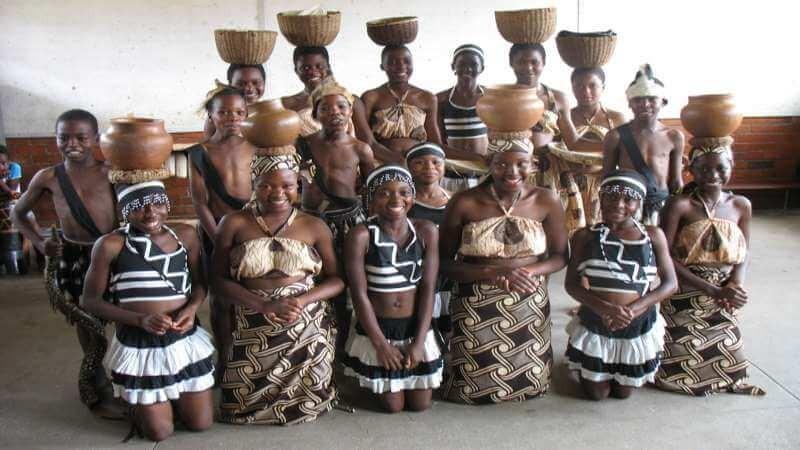
Shona Ceremonies - © African Crafts Market
What to Do in Nyanga
- Hiking in Nyanga National Park: Explore the scenic trails of Nyanga National Park and the surrounding mountains. Popular hikes include the trek to Mount Nyangani and walks through lush forests, where you can enjoy stunning views and diverse wildlife.
- Fishing in Nyanga: Nyanga is known for its excellent fishing spots, particularly in the area's lakes and rivers. Enjoy trout fishing in the pristine waters of Nyanga, where the cool climate and clear waters create ideal conditions for this relaxing activity.
- Birdwatching in Nyanga: The diverse ecosystems of Nyanga attract a variety of bird species. Birdwatchers can spot numerous birds, including the rare Black Eagle and various endemic species, making it a prime destination for avian enthusiasts.
- Cultural Tours: Engage with local communities and learn about traditional Shona culture through guided tours. These tours often include visits to local villages, cultural workshops, and opportunities to participate in traditional ceremonies.
Shopping in Nyanga
- Local Markets: Nyanga’s markets are bustling with activity and provide a range of goods from fresh produce to traditional crafts. Explore these markets to find unique items such as Shona carvings, woven baskets, and colorful textiles.
- Handcrafted Art Stores: Nyanga is renowned for its handcrafted art, including intricate stone sculptures and wooden carvings. These pieces are often made by local artisans and reflect the region’s rich cultural heritage.
- Traditional Textiles Stores: Purchase traditional Zimbabwean textiles, such as brightly colored fabrics and hand-woven items. These textiles are often used in traditional clothing and home décor, offering a tangible connection to Nyanga’s cultural traditions.
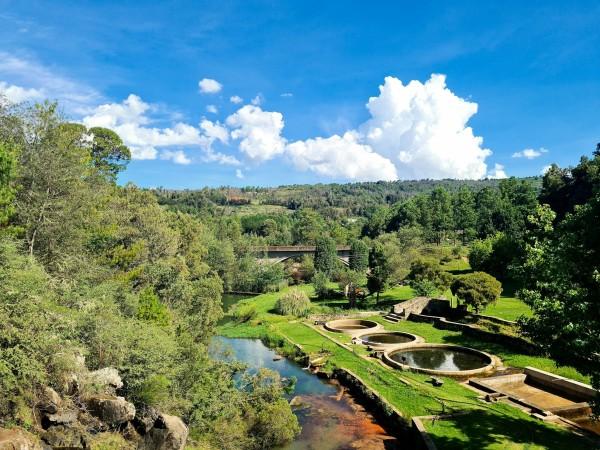
Uncover all the best of Nyanga - © Rutendo Petros
Weather in Nyanga: Best Time to Visit
Spring in Nyanga
Spring sees a gradual warming of temperatures and increased rainfall, with temperatures ranging from 15°C to 25°C (59°F to 77°F). The landscape begins to bloom, making it a beautiful time for photography and nature exploration. The rejuvenated vegetation and blooming flowers enhance the beauty of Nyanga National Park and the surrounding areas, providing a picturesque backdrop for outdoor activities and cultural experiences.
Summer in Nyanga
Nyanga's summer temperatures range from 20°C to 25°C (68°F to 77°F). This period is characterized by frequent, light rain showers that enhance the lush green landscape, making it an excellent time for hiking and nature walks. The vibrant scenery and cooler temperatures are ideal for exploring the extensive trails in Nyanga National Park and visiting attractions like Mutarazi Falls. Summer also coincides with the harvest festivals, providing visitors with an opportunity to experience local cultural celebrations and community events.
Autumn in Nyanga
Autumn brings colder, drier weather, with temperatures falling to between 10°C and 20°C (50°F to 68°F). This season is perfect for outdoor activities like birdwatching and fishing, as the dry conditions provide clear visibility and excellent fishing opportunities in the region’s lakes. The crisp air and reduced rainfall make autumn an ideal time for exploring the scenic viewpoints and enjoying the tranquil beauty of Nyanga’s landscapes.
Winter in Nyanga
Winter in Nyanga is dry with temperature ranging from 10°C to 20°C (50°F to 68°F). The sunny weather and cooler temperatures are great for hiking and adventure activities. Winter is also a popular time for visitors who enjoy cooler temperatures while exploring the area's natural wonders and participating in cultural tours. The clear skies offer excellent visibility for panoramic views from spots like World’s View.
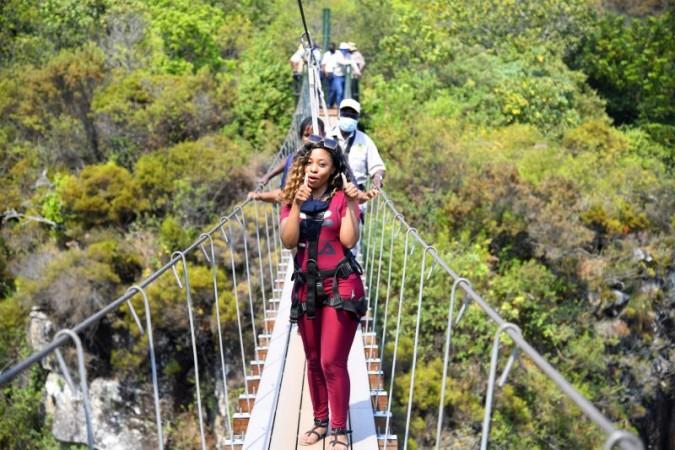
Experience the breathtaking natural beauty of Nyanga - © Zimbabwe Tourism
Essential Travel Information
Getting Around Nyanga
- Private Vehicles: Renting a car is a popular option for exploring Nyanga at your own pace. The region has well-maintained roads, and having a private vehicle allows for flexible travel to various attractions and remote areas.
- Public Buses and Minibuses: Public buses and minibuses operate between Nyanga and major cities such as Harare and Mutare. These are cost-effective options for travelers looking to explore the area without a private vehicle.
- Taxis: In Nyanga, local taxis are available for short trips and local transportation. They are a convenient way to get around town and reach specific destinations.
ATM & Banking Services
In Nyanga, managing your finances is straightforward with readily available ATM and banking services. ATMs are conveniently located around the town center, providing easy access to cash and supporting major international networks for card withdrawals. For broader financial needs, local banks offer a range of services including currency exchange, cash withdrawals, and general banking transactions during regular business hours. While the local currency is the Zimbabwean dollar, US dollars are also commonly accepted, making it helpful to carry both for various transactions.
Where to Stay in Nyanga
- Luxury Hotels: For those seeking premium comfort, luxury lodges provide high-end amenities and breathtaking views. These lodges often feature spacious rooms, gourmet dining options, and exclusive services such as guided tours and spa treatments, perfect for a lavish and relaxing experience.
- Mid-Range Hotels: Mid-range hotels strike a balance between comfort and affordability. These establishments offer essential amenities like well-appointed rooms, friendly service, and convenient locations, making them ideal for travelers looking for a comfortable yet budget-conscious stay.
- Guesthouses: Guesthouses and bed-and-breakfasts offer a more intimate and homely atmosphere. They typically provide personalized service, local insights, and cozy accommodations at a more economical rate, creating a welcoming environment for visitors.
Des articles pour vous

Voyage à Kampong Cham - Cambodge, Asie
Kampong Cham est une charmante ville riveraine située le long du fleuve Mékong. Connue pour son importance historique et ses attractions culturelles, Kampong Cham offre un mélange d'architecture coloniale, de temples anciens et de paysages pittoresques. Kampong Cham est reliée au district voisin de Tbong Khmum par le pont Kizuna, le premier pont au Cambodge à traverser le fleuve Mékong, en faisant un carrefour de transport crucial pour la région.
Population : Estimation de 80 000 habitants (en 2024)
Économie : Bien que n'étant pas encore une destination touristique majeure, Kampong Cham propose des sites culturels et historiques, tels que le temple Wat Nokor et le pont en bambou de Koh Pen, ainsi que des attractions naturelles comme des forêts et des chutes d'eau. Le gouvernement se concentre sur le développement du tourisme pour améliorer l'économie locale.
Points d'intérêt : Wat Nokor Bachey, Phnom Han Chey, Phnom Pros et Phnom Srey, pont en bambou de Koh Pen, Wat Joy T'maw, Preah Theat Teuk Chha, piste d'atterrissage abandonnée de l'US.

Explorez Nha Trang - Voyage au centre du Vietnam, Asie
Nichée le long de la magnifique côte du Vietnam, Nha Trang se distingue comme une destination de premier choix pour les voyageurs. Cette ville côtière, réputée pour ses superbes plages et sa vie marine foisonnante, s'adresse à tous. Nha Trang vous accueille à bras ouverts, que vous recherchiez des aventures, de la culture ou de la détente au bord de la mer. Ce guide vous fera découvrir les points forts de cet endroit magnifique, facilitant ainsi la planification de votre voyage de manière fluide et excitante.
Population : Environ 423 000 habitants en 2019.
Économie : L'un des principaux centres touristiques du Vietnam et la plus grande économie de la province de Khanh Hoa.
Sites emblématiques : Célèbre pour les tours Cham de Po Nagar, la cathédrale de Nha Trang et l'île Hon Mun.

Voyage à Sihanoukville - Cambodge, Asie
Sihanoukville, une ville côtière du sud-ouest du Cambodge, est la capitale de la province de Preah Sihanouk. Située sur une péninsule le long du golfe de Thaïlande, la ville est bien reliée à Phnom Penh par des autoroutes principales et dispose d'un aéroport international.
La ville abrite le seul port en eau profonde du Cambodge, jouant un rôle crucial dans la logistique et le commerce du pays. Les plages magnifiques de Sihanoukville, telles qu'Ochheuteal et Serendipity, attirent aussi bien les touristes nationaux qu'internationaux. Le développement économique a prospéré ces dernières années, en particulier grâce à la création de la Zone économique spéciale de Sihanoukville (SSEZ) et aux investissements chinois dans les casinos, l'immobilier et les stations balnéaires. La ville offre également des attractions naturelles telles que le parc national de Ream et plusieurs îles voisines, en faisant une destination variée pour les voyageurs d'affaires et de loisirs.
Population : La population de Sihanoukville était d'environ 160 000 habitants en 2024.
Économie : Sihanoukville, une ville côtière en pleine croissance au Cambodge, se distingue par son mélange dynamique de développement économique et de tourisme. La Zone économique spéciale de Sihanoukville (SSEZ) est devenue un pôle industriel majeur, abritant plus de 180 entreprises et créant des milliers d'emplois. Avec le seul port en eau profonde du Cambodge, la ville joue un rôle clé dans le commerce et la logistique du pays. Bien qu'elle se soit transformée d'une petite ville balnéaire tranquille en un centre urbain animé, Sihanoukville reste célèbre pour ses plages immaculées, attirant des touristes tout au long de l'année. Les investissements chinois importants ont alimenté la croissance des hôtels, des casinos et de l'immobilier, faisant de la ville un centre d'opportunités économiques et d'hospitalité.
Monuments : Plage d'Otres, Plage d'Ochheuteal, Plage de l'Indépendance, Parc national de Ream, Chute d'eau de Kbal Chhay, Monument des Lions d'Or, Wat Leu.

Explorez Kharkhorin - Voyage en Mongolie, Asie
Bienvenue à Kharkhorin, un trésor historique niché au cœur de la Mongolie. Ancienne capitale vibrante de l'Empire Mongol sous le légendaire Gengis Khan, Kharkhorin se dresse comme un témoignage de la riche culture et de l'histoire de la Mongolie. Cette ville antique possède une combinaison unique d'importance historique et de paysages époustouflants, en faisant une destination incontournable pour un voyage de rêve en Mongolie. En mettant le pied à Kharkhorin, vous ferez un saut dans le temps, à une époque de grands palais, de routes commerciales prospères et d'échanges culturels sans pareils. Que vous soyez intrigué par les ruines anciennes, désireux d'explorer les traditions locales ou simplement en quête d'une immersion dans la beauté naturelle de la Mongolie, Kharkhorin a quelque chose à offrir à chacun.
Population : Environ 1 000 habitants en 2020.
Économie : L'une des attractions touristiques les plus importantes de la Mongolie et l'ancienne capitale de l'Empire Mongol.
Monuments : Célèbre pour les Ruines de Kharkhorin, le Monastère d'Erdene Zuu, et la Vallée d'Orkhon, un site du patrimoine mondial de l'UNESCO.

Explore Luang Prabang - Laos Travel, Asia
Luang Prabang, nestled in northern Laos at the meeting point of the Mekong river and Nam Khan river, is a city celebrated for its rich cultural heritage and stunning natural beauty. Recognized as a UNESCO World Heritage Site in 1995, it boasts a unique blend of traditional Lao and French architecture that has been carefully preserved. Whether you're wandering through its ancient temples, admiring the local architecture, or soaking in the natural beauty of waterfalls and rivers, Luang Prabang offers something for everyone.
Population: Approximately 470,000 in 2020.
Economy: Luang Prabang's economy thrives on tourism, with its UNESCO status drawing visitors to its temples, natural wonders, and cultural experiences. Local crafts, hospitality, and small businesses also play vital roles, supporting the town's sustainable growth. Local crafts, hospitality, and small businesses also play vital roles, supporting the town's sustainable growth.
Landmarks: Famous for the Wat Xieng Thong, Royal Palace Museum (also known as Haw Kham), and Mount Phousi (Phou Si Hill).Luang Prabang, nestled in northern Laos at the meeting point of the Mekong river and Nam Khan river, is a city celebrated for its rich cultural heritage and stunning natural beauty. Recognized as a UNESCO World Heritage Site in 1995, it boasts a unique blend of traditional Lao and French architecture that has been carefully preserved. Whether you're wandering through its ancient temples, admiring the local architecture, or soaking in the natural beauty of waterfalls and rivers, Luang Prabang offers something for everyone.
Population: Approximately 470,000 in 2020.
Economy: Luang Prabang's economy thrives on tourism, with its UNESCO status drawing visitors to its temples, natural wonders, and cultural experiences. Local crafts, hospitality, and small businesses also play vital roles, supporting the town's sustainable growth. Local crafts, hospitality, and small businesses also play vital roles, supporting the town's sustainable growth.
Landmarks: Famous for the Wat Xieng Thong, Royal Palace Museum (also known as Haw Kham), and Mount Phousi (Phou Si Hill).

Explore Vientiane - Laos Travel, Asia
Vientiane, the capital of Laos, offers a unique travel experience for those looking to explore a peaceful Southeast Asian city with a deep connection to its cultural roots. Unlike other bustling capitals, Vientiane boasts a serene and laid-back atmosphere, making it a perfect destination for travelers wanting to escape the chaos of more crowded cities. This charming city sits along the Mekong River, offering scenic views, rich history, and a vibrant yet tranquil way of life. As a gateway to exploring Laos, this capital invites you to slow down, immerse in its heritage, and enjoy the local flavors.
Population: Approximately 840,000 in 2023.
Economy: Vientiane's economy is growing steadily, driven by government services, trade, and tourism. Key sectors include agriculture, manufacturing, and construction. The city's strategic location along the Mekong River supports trade with neighboring Thailand and Vietnam.
Landmarks: Famous for the Pha That Luang, Patuxai, and the Buddha Park (or Wat Xieng Khuan).
